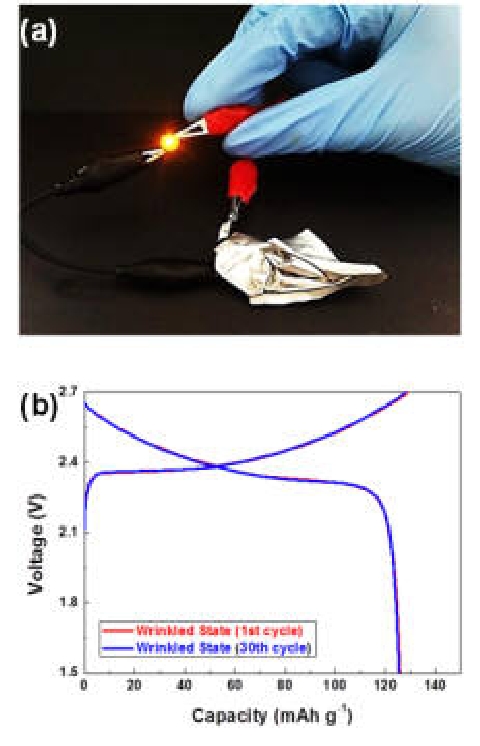Korean researchers developed the original technology for the lithium secondary battery, which works normally without explosion even if severely crumpled. This technology is expected to be used to develop the power supply for various ‘flexible electronic devices’ like smartphones on your wrist, scroll displays and wearable computers.
The joint research team, consisting of Prof. Lee Sang-yeong of Ulsan National Institute of Science and Technology and Dr. Kim Je-yeong of LG Chem Battery Research Lab, announced that they developed a thin, freely transformable and stable lithium secondary battery.
As existing lithium secondary batteries may explode if severely transformed, it has been applied to flexible devices to a limited extent. Existing lithium secondary batteries, made up of liquid electrolytes and separators, generate heat if transformed. If the separator is melted by this heat, the cathode and the anode come in contact and may explode.
The polymer electrolyte is regarded as a substitute, but its electrochemical performance, thickness and flexibility are not good enough to be used in ‘flexible batteries.’ The research team used the ‘plastic crystal polymer electrolyte’ to solve this problem. The plastic crystal is a matter with physical properties in between the crystal (taking form) and melted (melted and blended) state. If it is used as an electrolyte, it shows excellent ion conductivity and heat resistance.
It has been shown that the electrolyte developed by this research team performs as well as the liquid electrolyte, but never deteriorates ion conductivity at a high temperature (80℃). Also, it is 10 times thinner than the existing polymer electrolyte, and has 30 times greater mechanical flexibility. When the plastic crystal polymer electrolyte was applied to the lithium secondary battery, it was confirmed that it worked safely and normally without generating any heat or exploding even if the battery is severely crumpled or rolled like the telephone wire.
As this electrolyte can play the role not only as an electrolyte, but also as a separator in the battery, it may be used to develop a ‘battery without a separator.’ The result of this study, conducted under the support of the ‘Converging Research Center Program’ through the Ministry of Science, ICT & Future Planning, was selected as the rear cover paper for the latest issue of ‘Advanced Functional Materials,’ a prestigious journal in materials science.
◇ Polymer Electrolytes= a kind of electrolyte delivering ions inside the battery. Unlike the existing liquid electrolyte currently used in commercial batteries, this electrolyte is manufactured using polymers, and it is greatly improved in terms of leakage suppression and safety.
Ryu Gyeong-dong | ninano@etnews.com
구겨지는 이차전지 기술, 휴대기기 신기원
<신규 고분자전해질이 적용된 리튬이차전지는 심하게 구겨진 상태에서도 전지의 단락 없이 정상적인 성능을 보인다. 구겨진 리튬이차전지로 전구에 불을 밝히는 모습. <자료: 미래부>>
심하게 구겨진 상태에서도 폭발 없이 정상적으로 작동하는 리튬이차전지 원천기술을 국내 연구진이 개발했다. 기술은 손목에 차는 스마트폰, 두루마리 형태 디스플레이, 입는 컴퓨터 등 다양한 `휘는(flexible) 전자기기` 전원을 개발하는 데 적용될 것으로 기대된다.
울산과학기술대학교 이상영 교수와 LG화학 배터리연구소 김제영 박사의 공동연구팀은 얇고 자유자재로 변형 가능하며, 안정적인 리튬이차전지를 개발했다고 밝혔다.
기존 리튬 이차전지는 심하게 변형시키면 폭발할 수 있어 유연한 기기에 적용하는 데 한계가 있었다. 액체 전해질과 분리막으로 구성된 기존 리튬이차전지는 변형시키면 열이 발생하는데, 이 열에 의해 분리막이 녹으면 양극과 음극이 접촉해 폭발할 수 있다.
고분자 전해질이 대체재로 고려되고 있지만 `휘는 전지`에 쓰이기에는 전기화학적 성능과 두께, 유연성이 부족하다는 평을 받고 있다. 연구팀은 `플라스틱 크리스털 고분자 전해질`을 이용해 이 문제를 해결했다. 플라스틱 크리스털은 결정(형태를 이룸)-용융(녹아서 섞임) 상태가 아닌 그 중간 물리적 특성을 보이는 물질. 전해질로 사용하면 우수한 이온전도도와 내열성을 보인다.
연구팀이 개발한 전해질은 액체 전해질 수준의 성능을 유지하면서도 고온(80℃)에서 이온 전도도가 전혀 저하되지 않는 것으로 나타났다. 또 기존의 고분자 전해질보다 두께가 약 10배 얇고, 기계적 유연성은 30배 높은 것으로 측정됐다. 플라스틱 크리스털 고분자 전해질을 리튬이차전지에 적용한 결과, 전지를 심하게 구기거나 전화선처럼 둘둘 만 상태에서도 발열이나 폭발 없이 안전하게 정상 작동하는 것으로 확인됐다.
전해질은 전지 내에서 전해질 역할뿐 아니라 분리막 기능도 할 수 있어 `분리막 없는 전지` 개발에 이용될 수도 있다. 미래부 `신기술융합형성장동력사업`의 지원을 받아 수행된 이 연구의 결과는 재료과학분야 권위지인 `어드밴스트 펑셔널 머티리얼스`(Advanced Functional Materials) 최신호 후면 표지논문으로 선정됐다.
◇고분자전해질(Polymer Electrolytes)= 전지 내부에서 이온 전달 기능을 담당하는 전해질(electrolytes)의 한 종류. 현재 상업화 전지에 사용되는 액체 상태의 전해액과는 달리 고분자를 이용하여 고체 상태로 제조한 전해질로 누액 억제 및 안전성이 크게 향상된 특징을 갖는다.
류경동기자 | ninano@etnews.com
